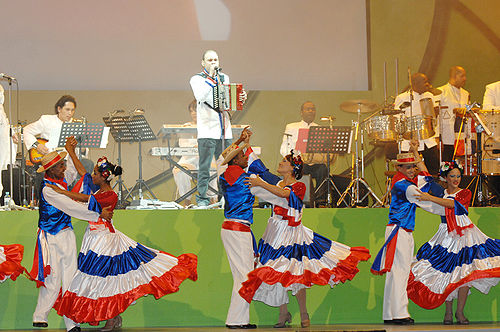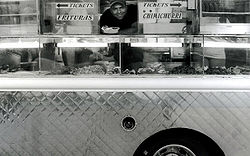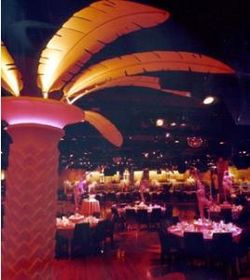From From the Island to the City: Dominican Communities in New York City
Assimilation Made Easy
When an immigrant is introduced to a new country, it can be difficult to construct new social ties to replace those that are lost. This reconstruction of social life occurs while participating in the normal activities that life demands. These activities include providing for a family, learning a new language, engaging in social activities, and going to church. Social institutions and organizations in immigrant communities provide these programs by which immigrants can create new social ties. Social Institutions for Dominicans include the Dominican Women’s Development Center (DWDC/El Centro), Alianza Dominicana, the New York Dominican Officers Organization (NYDO), The Community Association of Progressive Dominicans (ADCP), Cultarte, and El Repertorio Espanol.
Rediscovering the Culture of an Unfamiliar Homeland
American-born Dominicans and their immigrant counterparts who arrived in the United States at a young age often have a hard time regaining contact with the arts and culture of The Dominican Republic – their true identity is almost lost, and they essentially grow up American. To counter this loss of culture, in New York City there is a wealth of ethnic establishments that sustain the Dominican customs, arts, and energy. Institutions such as the Northern Manhattan Arts Alliance (NoMAA), Culturarte, and other distinct pieces of Dominican culture aid in revitalizing the life of Dominican ethnicity in New York.
Arts and Culture
- The Northern Manhattan Arts Alliance (NoMAA) is a non-profit arts organization, affiliated with the Hispanic Federation and supported by the Upper Manhattan Empowerment Zone. The Alliance aims to “foster the diverse artistic expressions of artists and cultural organizations throughout Washington Heights and Inwood.” [2] In addition, the organization funnels funds to its neighborhoods of service and provides grants to low-income artists from under-served communities. And as a result of the concentration of Dominican immigrants in NoMAA’s target locations, (namely Washington Heights and Inwood) Dominican art pervades exhibits by the organization. The fruit of NoMMA's labors provides for one thing more than any - it allows Dominicans or people from any other ethnic background to partake in Dominican culture by visiting any of the events hosted by the Northern Manhattan Alliance. [3]
- The Uptown Arts Stroll is the Northern Manhattan Arts Alliance’s most popular annual event.
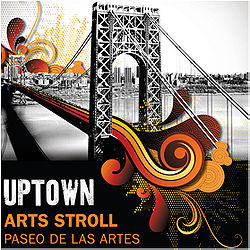
Uptown Arts Stroll Banner
[4]
- Culturarte
- Culturarte is a community space located in Washington Heights. It provides support, such as free classes and free art supplies, to help Dominican Americans keep in touch with their heritage and culture. This center hones pride for the Dominican culture, and helps recent Dominican immigrants feel more at home in the United States. Culturarte also provides artistic outlets for new immigrants to try to avoid the ills of inner-city life such as drugs and crime.
Tasting and Living the Culture
Even though the Dominican culture is well represented through arts and performances by way of NoMAA, there are still essential parts of the cultural experience missing. For example, food and dancing are cornerstones of Dominican social interaction, and New York City provides places for these to flourish.
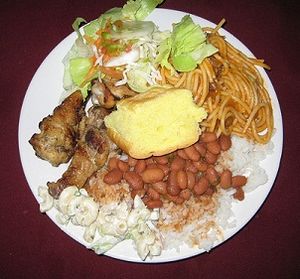
Chicharrones - Fried Pork Rinds
[7]
- Those searching for exquisite, authentic Dominican cuisine should be sure to stop at El Lina. El Lina is a bona fide Dominican restaurant whose enticing aromas captivate passersby and converts them into customers. The restaurant's “Dominican waitresses are flirtatious, and the best ones can pack the lunch counter three rows deep with admirers.’” [8] But if people just want a quick, convenient taste of the Dominican Republic, Dominican food carts are popular in areas such as Corona, Queens and Washington Heights. Food carts serve Dominican favorites such as fried empanadas with cheese or meat, coconut juices, and a sweet bean soup known as habichuelas con dulce.
- If the authentic Dominican food options can't satiate a desire for Dominican culture, there are plenty of clubs around New York City that sport Dominican vibes, with Latin music resonating within the walls. New York's Dominican clubs bring together the traditional and more contemporary atmospheres. In Jackson Heights, Queens there is D'Antigua which sports Latin alternative music to which patrons can strut their Merengue and Bachata skills. In addition, Coppacabana, a Dominican dance club celebrated by many Dominicans in New York City, brings Dominican nightlife to New York. The dance club draws in mostly Dominican youth so that they are able to mingle in a casual setting and find like-minded peers.
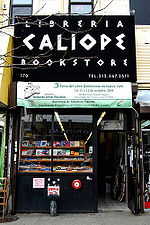
Libreria Caliope storefront
- However, dancing and food are not the only offerings for Dominicans. Librería Caliope is considered to be the neighborhood intellectual hub in Washington Heights. It contains thousands of books authored by Dominicans and encourages education and intellectual discussions within the community in Washington Heights. One customer of Librería Caliope says, "[They have] plenty of Dominican history books. When you get that itch, this is a great place in the neighborhood to begin exploring your roots."
References
- ↑ http://www.nomaanyc.org/node
- ↑ Northern Manhattan Alliance (NoMAA). "Mission and History." Northern Manhattan Arts Alliance. Northern Manhattan Arts Alliance (NoMAA), 2010. Web. 21 Mar. 2010. <http://www.nomaanyc.org/node/3>.
- ↑ Testing
- ↑ http://www.artstroll.com/
- ↑ Northern Manhattan Arts Alliance. "Uptown Arts Stroll 2009." Uptown Arts Stroll. Northern Manhattan Arts Alliance (NoMAA), 2010. Web. 21 Mar. 2010. <http://www.artstroll.com/>.
- ↑ Kugel, Seth. "Uptown in the Caribbean." New York Times [New York] 27 Oct. 2007, Weekend in New York ed., Dominican Culture sec.: n. pag. Web. 21 Mar. 2010.<http://travel.nytimes.com/2007/10/28/travel/28weekend.html>.
- ↑ http://www.squidoo.com/Dominican-Republic-Travel-And-Information?utm_campaign=direct-discovery
- ↑ McLane, Daisann. "Dominican Restaurants: A New Beat in Nueva York." New York
Times [New York] 27 May 1992: n. pag. Web. 21 Mar. 2010.<http://www.nytimes.com/1992/05/27/garden/dominican-restaurants-a-new-beat-in-nueva-york.html?pagewanted=>.



